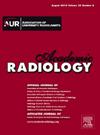通过优化生物标志物方法从胸腔恶性肿瘤患者治疗前的 CT 图像预测放疗诱发的心血管毒性
IF 3.8
2区 医学
Q1 RADIOLOGY, NUCLEAR MEDICINE & MEDICAL IMAGING
引用次数: 0
摘要
理由和目的:心血管毒性是众所周知的胸部放射治疗(RT)的并发症,导致发病率和死亡率增加,但现有的预测心血管毒性的技术有局限性。心血管毒性的预测性生物标志物可能有助于最大化患者的预后。方法:采用机器学习最佳生物标志物(OBM)方法来预测接受rt治疗的胸部恶性肿瘤患者的计算机断层扫描(CT)图像的心脏毒性发展(基于左心室射血分数和纵向应变的连续超声心动图测量)。对125名胸部恶性肿瘤患者的治疗前非增强CT模拟图像进行了10个感兴趣的心血管目标的人工分割(41名患者)发生心脏毒性,84例在RT后没有发生)。我们提取了描述这些物体的形态学、图像强度和纹理的1078个特征,并确定了其中最不相关的5个特征,这些特征显示了区分心脏毒性/无心脏毒性的最佳能力。在这5个特征的所有可能组合中选出预测准确率最高的最佳组合,然后在此组合上训练SVM分类器,并在独立数据集上测试预测准确率。对每个目标的最优特征进行量化预测精度。结果:基于5个基于ct的左心室特征的最佳特征组合在所有对象中测试预测准确率最高,为0.88。对所有物体的预测精度在0.76-0.88之间。心脏、左心房、主动脉弓、胸主动脉和胸降主动脉的准确率次之,为0.84。最优特征是基于共现矩阵的纹理属性。结论:通过机器学习技术,从现有的治疗前CT图像中预测个体胸部恶性肿瘤患者RT后的未来心脏毒性是可行的,准确率很高。本文章由计算机程序翻译,如有差异,请以英文原文为准。
Prediction of Radiation Therapy Induced Cardiovascular Toxicity from Pretreatment CT Images in Patients with Thoracic Malignancy via an Optimal Biomarker Approach
Rationale and Objectives
Cardiovascular toxicity is a well-known complication of thoracic radiation therapy (RT), leading to increased morbidity and mortality, but existing techniques to predict cardiovascular toxicity have limitations. Predictive biomarkers of cardiovascular toxicity may help to maximize patient outcomes.
Methods
The machine learning optimal biomarker (OBM) method was employed to predict development of cardiotoxicity (based on serial echocardiographic measurements of left ventricular ejection fraction and longitudinal strain) from computed tomography (CT) images in patients with thoracic malignancy undergoing RT. Manual segmentations of 10 cardiovascular objects of interest were performed on pre-treatment non-contrast-enhanced CT simulation images in 125 patients with thoracic malignancy (41 who developed cardiotoxicity and 84 who did not after RT). 1078 features describing morphology, image intensity, and texture for each of these objects were extracted and the top 5 features among them that were most uncorrelated and showed the best ability to discriminate between cardiotoxicity/ no cardiotoxicity were determined. The best combination among all possible combinations among these 5 features that yielded the highest accuracy of prediction on a training data set was selected, an SVM classifier was then trained on this combination, and tested for prediction accuracy on an independent data set. Prediction accuracy was quantified for the optimal features derived from each object.
Results
The best feature combination based on 5 CT-based features derived from the left ventricle had the highest testing prediction accuracy of 0.88 among all objects. Prediction accuracies over all objects ranged from 0.76–0.88. Heart, Left Atrium, Aortic Arch, Thoracic Aorta, and Descending Thoracic Aorta showed the next best accuracy of 0.84. Most optimal features were texture properties based on the co-occurrence matrix.
Conclusion
It is feasible to predict future cardiotoxicity following RT with high accuracy in individual patients with thoracic malignancy from available pre-treatment CT images via machine learning techniques.
求助全文
通过发布文献求助,成功后即可免费获取论文全文。
去求助
来源期刊

Academic Radiology
医学-核医学
CiteScore
7.60
自引率
10.40%
发文量
432
审稿时长
18 days
期刊介绍:
Academic Radiology publishes original reports of clinical and laboratory investigations in diagnostic imaging, the diagnostic use of radioactive isotopes, computed tomography, positron emission tomography, magnetic resonance imaging, ultrasound, digital subtraction angiography, image-guided interventions and related techniques. It also includes brief technical reports describing original observations, techniques, and instrumental developments; state-of-the-art reports on clinical issues, new technology and other topics of current medical importance; meta-analyses; scientific studies and opinions on radiologic education; and letters to the Editor.
 求助内容:
求助内容: 应助结果提醒方式:
应助结果提醒方式:


